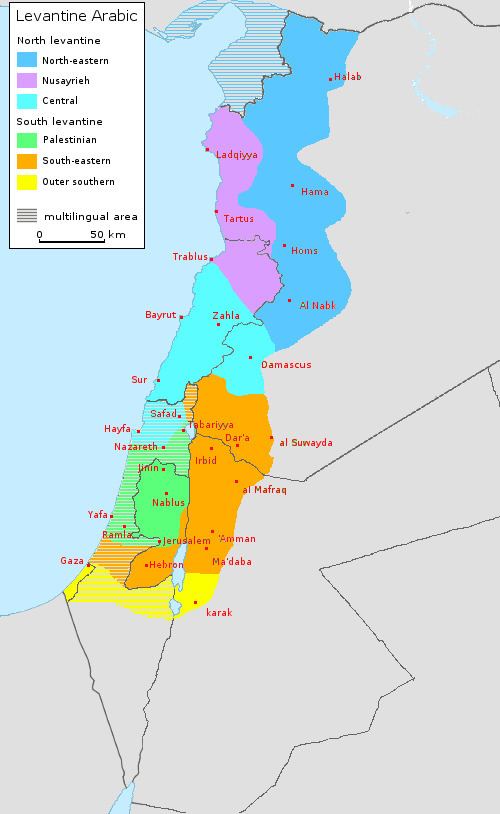Glottolog leva1239 | ||
 | ||
Native speakers (21 million cited 1991–1996) ISO 639-3 Variously:apc – North Levantineajp – South Levantineacy – Cypriot Arabic | ||
Levantine Arabic (Arabic: اللهجة الشامية, ʾal-lahǧatu š-šāmiyyah, Levantine Arabic: il-lahže š-šāmiyye) is a broad dialect of Arabic spoken in the 100 to 200 km-wide Eastern Mediterranean coastal strip. It is considered one of the five major varieties of Arabic. In the frame of the general diglossia status of the Arab world, Levantine Arabic is used for daily spoken use, while most of the written and official documents and media use Modern Standard Arabic.
Contents
Classification
Levantine Arabic is most closely related to North Mesopotamian Arabic, Anatolian Arabic, and Cypriot Maronite Arabic. These four varieties are descended from a common variety of northern Old Arabic.
Geographical Distribution
Levantine Arabic is spoken in the fertile strip on the eastern shores of the Mediterranean. To the East, in the desert, one finds North Arabian Bedouin varieties. The transition to Egyptian Arabic in the South via the Negev and Sinai desert where Bedouin varieties are spoken and then the Egyptian Sharqiyya dialect, was described by de Jong in 1999,. In this direction, the Egyptian city of El Arish is the last one to display proper Levantine features. In a similar manner, the region of el-Karak announces Hijazi Arabic. In the North, the limit between Mesopotamian Gilit dialects starts from the Turkish border near el-Rāʿi, and the lake Jabbul is the north-eastern limit of Levantine Arabic, which includes further south el-Qaryatayn Damascus and the Hauran mountains.
History
Certain areal features of Central Semitic, like the definite article and the at > ah sound change, radiated out from the central Levant. Their occurrence in Arabic suggests that the language in its earliest stages was geographically contiguous with the NWS languages in which these areal features also occur. Arabic would have thus entered the Arabian Peninsula afterwards in a series of pre-Islamic migrations.
The identification of isoglosses that appear in the ancient evidence and the modern Levantine dialects suggests continuity in the Arabic of the Levant from ancient times to the present. Nevertheless, contact between indigenous northern and later southern varieties of Arabic was integral to the development of modern Levantine Arabic.
As an illustrative example of this contact situation, Cypriot Maronite Arabic and the 9th century Damascus Psalm Fragment (Psalm 78) both attest to the existence of an ancient Levantine process of pre-tonic /a/ raising: *sallámtu > sillámt. Cypriot Maronite Arabic stems in large part from the Arabic spoken by Levantine Maronites during the 12th and 13th centuries and represents a variety of Levantine Arabic that has come under considerably less influence from the imperial idiom and interaction with non-Levantine dialects. Likewise, the Damascus Psalm Fragment was produced, for the most part, before the mass influx of Peninsular Arabic following the advent of Islam and outside the tradition of writing in Classical Arabic. This allophonic a-raising is today restricted to a few rural varieties of Levantine Arabic. Instead, analogically leveled forms appeared to have moved from the east into cities and then radiated outwards, affecting nearby rural dialects later. The urban and oasis dialects of the Levant and Mesopotamia (Nabk, Soukhne, Palmyra, Damascus, Aleppo, Baghdad) have come under the most contact with forms of Arabic originating in the Najd and thus reflect centuries of leveling and development. The urban core of modern Levantine Arabic was borne out of this contact situation.
